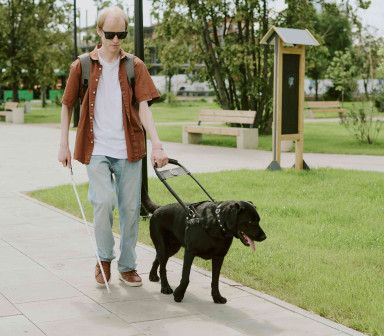For blind or partially sighted people, the choice between using a cane or a guide dog is often a personal one.
There are a number of options to explore to help navigate the environment safely and as independently as possible when out and about.

Types of cane
There are several different types of canes available for people with a visual impairment:
A long cane is used to detect objects in the user’s path. Usually measuring from sternum to floor, its length means the cane is always one or two steps ahead, allowing the user to detect obstacles and then avoid them and find a way into a shop or down stairs.
A guide cane is shorter than the long cane, extending only to the user’s waist, and can be used to detect kerbs and steps.
A symbol cane is a light and short cane primarily used to alert others to the user’s visual impairment.
A support cane's main function is to support a user who may need additional physical stability, e.g., due to age or an injury.
A Guide Dog
Guide dogs are trained to help visually impaired people navigate their environment. The dog is fitted with a body harness and a handle which is connected to the harness. Like this, the guide dog is able to guide the person who holds on to the handle. While the guide dog helps navigate the environment, it is important to remember the handler is the one in charge and has to tell the dog what to do. It is a partnership in which the owner provides clear direction to their dog and the dog ensures safe manoeuvring around obstacles.
Wayfinding with a guide dog is totally different to doing so with a long cane. The dog is taught to walk in a straight line and only deviates from this principle when instructed by its handler or to avoid an obstacle.
Benefits of a guide dog
Travelling with a guide dog tends to be smoother than with a cane and is often quicker, especially when the dog is familiar with the route. However, it is up to the handler to tell the dog where to go, where to turn, or when to cross a street. The dog does not know whether its handler wants to go to a friend’s house or to the supermarket, especially when both are on the same route.
A guide dog can help the user keep his line of direction more easily than a cane and will also guide the handler around obstacles such as A boards, lampposts and overhanging bushes.
The application process with the charity Guide Dogs ensures a good match between dog and handler i.e. for walking speed, work load, transport needs, family situation etc. Many guide dog owners feel that using a guide dog increases the public’s awareness and understanding of their visual impairment.
Handling a guide dog
It is important to factor in the responsibilities that come with being a guide dog owner when making a decision. Like any pet, a guide dog needs to be walked regardless of the weather conditions and, like any responsible dog owner, you will be expected to make a reasonable effort to clean up after your dog. A guide dog requires a workload to maintain its training and part of the Guide Dog assessment will be to ensure the applicant has enough work (i.e. routes from and to home/work/shops etc) for the dog to do. A guide dog owner will be expected to feed the dog as advised by Guide Dogs and ensure the dog is taken to the vet regularly and when necessary.
The emotional bond formed with a guide dog can make it difficult to train with a new dog if your guide dog retires or passes away. At the same time, this emotional bond can be very beneficial for the guide dog owner and the dog can facilitate social contacts.
Deciding between cane use or a guide dog
The charity Guide Dogs encourages all guide dog owners to train with a long cane prior to using a guide dog. This is due to unexpected ill health or death of their guide dog or when it not suitable to take the dog to an event or location i.e. music festival. It also ensures that if your guide dog retires before a new dog is found you will still have access to a mobility aid.
There are many factors to consider when deciding between using a cane or a guide dog such as your level of sight loss, your personal circumstances and the amount of ‘workload’ you have for the dog.
There is a purpose in the Guide Dog application and assessment being a lengthy process as it allows the applicant plenty of time to reflect on the commitment of being a guide dog owner.
There will be times when using both a guide dog and cane might be useful, such as when learning a new route, and you may want to discover it with cane first before introducing it to the dog.
Both a rehabilitation officer and a Guide Dog Mobility Instructor (who trains the dog and Guide Dog Owners together and this is part of the application and assessment process) will be able to offer you clear and precise information about what mobility aid would be best suited to your needs. It is their role to ensure you build confidence when mobilising in your environment.
What is most important is that you feel comfortable. Guide dog mobility is not suited to everyone for many reasons such as health, family situation, low workload for the dog. A cane can be folded up and put away in the corner. A dog requires a lot of interaction, care and support.
Whatever the choice, both cane and canine are mobility tools that can greatly improve the quality of life, independence and confidence of a visually impaired person.